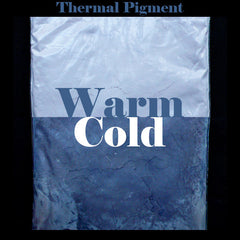Epoxy Resin Colouring | Color Changing Powder | Heat Sensitive Pigment | Thermochromic Pigment | Thermocolor Pigment | Thermal Pigment (Black / 4 grams)
Thermal pigment is a color changing pigment that changes from colored to translucent white at the temperature of 31C / 88F and above. Areas of...
Thermal pigment is a color changing pigment that changes from colored to translucent white at the temperature of 31C / 88F and above.
Areas of Use: Resin, paint, ink, etc.
Mixing Ratio: around 1-3%
You can mix the thermal pigments with a little bit of another pigments (can be thermal pigments or non thermal pigments) to achieve the desired color.
Mix with thermal pigments: If you mix red thermal pigment with blue thermal pigment to clear resin, you will get translucent white color above the temperature 31C / 88F and purple color under the temperature 31C / 88F.
Mix with non-thermal pigments: If you mix red thermal pigment with blue non-thermal pigment, you will get blue color above the temperature 31C / 88F and purple color under the temperature 31C / 88F.
Note: If you mix with non-thermal pigments, please add only a small portion of non-thermal pigment to test. Since there are too many pigments, so I am not able to tell the mixing ratio of thermal pigment with non-thermal pigments.
There are lots of mixing experiment you can do with these pigments. You can check how the color changed by using room heater and fridge, it can help you to check the mixing ratio.
Net Weight: 4 grams
Color: Black (Under 31C / 88F), Translucent White (Above 31C / 88F)
Notes:
1. The color in the cover image is just for reference only. It is because the shade of color depends on the amount of pigment and the temperature. The higher the temperature, the faster the color changes.
2. This pigment does not react to UV light.
3. Please keep unused products away from direct sunlight so it can keep changing color for years. Too much exposure to sunlight will shorten the life of the pigments.







